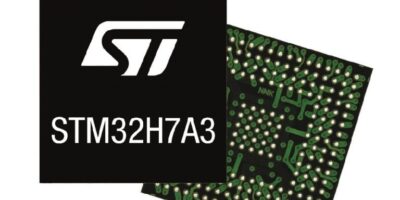Microcontrollers combine Cortex-M7 with memory and power for smart objects
Arm Cortex-M7 core performance, high memory density and power saving operation are combined in the STM32H7 microcontrollers, released by STMicroelectronics.
The STM32H7A3, STM32H7B3 and STM32H7B0 Value Line microcontrollers have low power consumption and start from economical 64-pin QFP packages and have levels of integration and real-time performance to handle functionalities like rich user interfaces, natural language interaction, RF mesh networking, and artificial intelligence (AI) for next-generation smart devices.
Support for embedded graphics includes up to 1.4Mbyte RAM that enables cost-effective support of advanced user interfaces on display resolutions up to HVGA with 24-bit colour without external SRAM, says STMicroelectronics.
Energy efficiency and increased DSP capability efficiently handle audio front-end and output generation for voice and audio processing, adds the company.
For applications that require advanced connectivity, the CPU performance and flash density handle evolving RF-communication protocols. The 4.57 x 4.37mm wafer-level chip-scale package (WLCSP) option is suitable for integration in wireless modules.
The STM32H7 microcontrollers also deliver the power efficiency needed for machine learning, STMicroelectronics says, and the performance to support future generations of neural networks.
For security-conscious IoT applications, cyber-protection includes secure boot / Root of Trust and hardware cryptographic/hash accelerators. On-the-fly decryption (OTFDEC) extends protection to code stored in external serial memories by allowing encrypted content to be decrypted in real-time.
Embedded secure-loading services allow users to order standard products anywhere in the world and deliver encrypted firmware to the programming partner. Once the product is authenticated and securely programmed, the Root of Trust mechanism supports all secure firmware services including field update.
Dual power domains allow flexible power management while voltage scaling enables optimum efficiency in run and stop modes. An on-chip switch mode power supply (SMPS) helps reduce the bill of materials (Bo) and can power the MCU circuitry and external components. There is a 32microA Stop mode with SMPS active and full RAM retention. Standby current is just four microA.
The STM32H7 microcontrollers have up to two octal SPI external memory interfaces, an RGB interface for up to XGA displays, ST’s Chrom-ART Accelerator to offload the CPU from 2D graphics operations, the Chrom-GRC to optimise support for non-rectangular displays, and hardware JPEG codecs.
The STM32 development ecosystem includes the STM32H7B3I-EVAL dedicated evaluation board, STM32H7B3I-DK discovery kit, and NUCLEO-H7A3ZI-Q Nucleo-144 board. The STM32CubeH7 software package includes application and demonstration examples with source code available, including graphical solutions based on TouchGFX technologies. There are also toolkits for motor control, AI application development, and the STM32Trust cyber-security ecosystem.
Samples of the STM32H7A3 and STM32H7B3, are available now. Full production for most derivatives has begun and the full portfolio will be available by June 2020.




